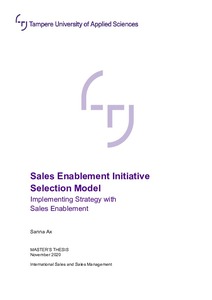Sales enablement initiative selection model : implementing strategy with sales enablement
Ax, Sanna (2020)
Julkaisun pysyvä osoite on
https://urn.fi/URN:NBN:fi:amk-2020120125336
https://urn.fi/URN:NBN:fi:amk-2020120125336
Tiivistelmä
The purpose of this master’s thesis was to develop a concrete model for selecting the sales enablement initiatives which support the implementation of the strategy of an organization. The objective was to contribute to the development of the field of sales enablement by examining how strategy implementation can be supported with sales enablement and by providing organizations with con-crete examples on how to make their sales enablement work proactive instead of reactive.
The constructivist research approach was selected since the aim was to create a concrete model to help solve a practical problem many sales enablement professionals face in their daily work and at the same time contribute to the academic research of sales enablement. Existing theoretical knowledge and half-structured theme interviews with sales experts were used to help define the term sales enablement and determine how it is linked to organizational strategy. To support the development of the model, different ways of working were test-ed and explored in practice in a case company, and Organizational Project Management (OPM) practices and methods were examined as a possible way to organize and prioritize sales enablement work.
The findings from the interviews implied that there is a connection between strategy and sales enablement. A good strategy was seen crucial for the success of sales enablement initiatives and difficulties in strategy formulation or implementation or situations where sales enablement was not a top-level priority were seen to result in various challenges that harmed the productivity and efficiency of the sales organization. The created model was based on the idea that sales enablement should help sales execute the strategy by selecting the right supporting initiatives, and management to formulate the strategy by making sure the sales process feeds vital customer information from the field to the management team. More work during a longer period is needed to define the applicability of the constructed model in different environments and to determine its contribution to the academic research of sales enablement.
The constructivist research approach was selected since the aim was to create a concrete model to help solve a practical problem many sales enablement professionals face in their daily work and at the same time contribute to the academic research of sales enablement. Existing theoretical knowledge and half-structured theme interviews with sales experts were used to help define the term sales enablement and determine how it is linked to organizational strategy. To support the development of the model, different ways of working were test-ed and explored in practice in a case company, and Organizational Project Management (OPM) practices and methods were examined as a possible way to organize and prioritize sales enablement work.
The findings from the interviews implied that there is a connection between strategy and sales enablement. A good strategy was seen crucial for the success of sales enablement initiatives and difficulties in strategy formulation or implementation or situations where sales enablement was not a top-level priority were seen to result in various challenges that harmed the productivity and efficiency of the sales organization. The created model was based on the idea that sales enablement should help sales execute the strategy by selecting the right supporting initiatives, and management to formulate the strategy by making sure the sales process feeds vital customer information from the field to the management team. More work during a longer period is needed to define the applicability of the constructed model in different environments and to determine its contribution to the academic research of sales enablement.
